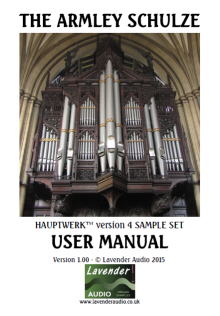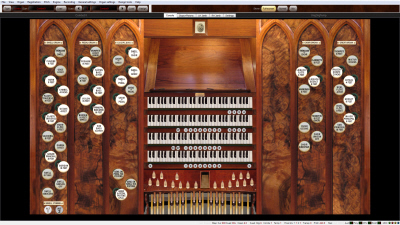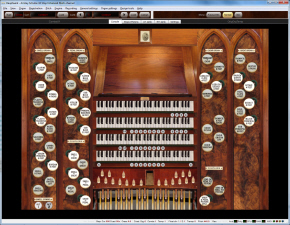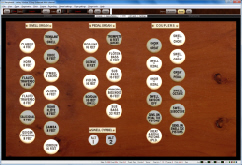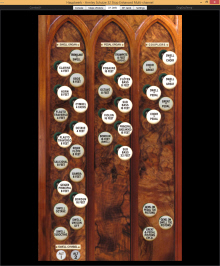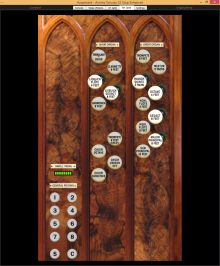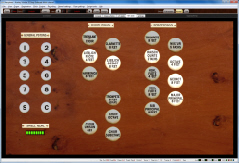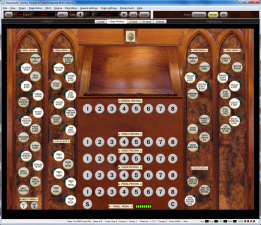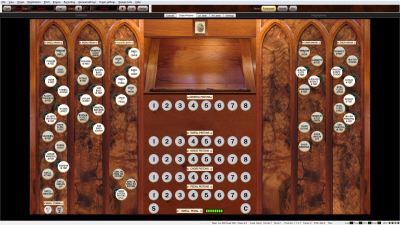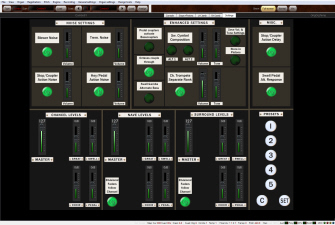
The Armley Schulze
Hauptwerk (v5 and upwards) Virtual Organ
Hauptwerk (v5 and upwards) Virtual Organ

© Lavender Audio 2008 -
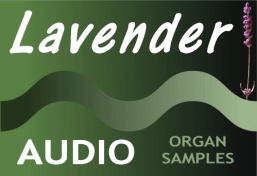
ARMLEY SCHULZE 32 STOP SAMPLE SET

HAUPTWERK SPECIFICATION - ARMLEY SCHULZE 32 STOP
GREAT (C - c4)
Sub Principal
Major Principal
Hohl Flöte
Gedact
Hohl Flöte
Octave
Rausch Quinte
Mixtur
Trompete
Swell to Great
Choir to Great
Major Principal
Hohl Flöte
Gedact
Hohl Flöte
Octave
Rausch Quinte
Mixtur
Trompete
Swell to Great
Choir to Great
16
8
8
8
4
4
II
V
8
SWELL (C - c4)
Bordun
Geigen Principal
Gamba
Salicional
*Celeste (tenor C)
Flauto Traverso
Octave
Flauto Traverso
Cymbel
Horn
Oboe
Clarine
Tremulant
Swell octave
Swell suboctave
Swell unison off
* this stop knob is labelled “Rohr Flöte”
Geigen Principal
Gamba
Salicional
*Celeste (tenor C)
Flauto Traverso
Octave
Flauto Traverso
Cymbel
Horn
Oboe
Clarine
Tremulant
Swell octave
Swell suboctave
Swell unison off
* this stop knob is labelled “Rohr Flöte”
16
8
8
8
8
8
4
4
IV
8
8
4
CHOIR (C - c4)
Harmonica
Lieblich Gedact
Lieblich Flöte
Clarinette
Tremulant
Trompete (Gt)
Choir octave
Choir suboctave
Choir unison off
Swell to Choir
Lieblich Gedact
Lieblich Flöte
Clarinette
Tremulant
Trompete (Gt)
Choir octave
Choir suboctave
Choir unison off
Swell to Choir
8
8
4
8
8
PEDAL (C - f1/ g1)
Sub Bass
Principal Bass Wood
Violon
Sub Bass
Bordun (Sw)
Octave
Flöten Bass
Posaune
Trompete (Gt)
Great to Pedal
Swell to Pedal
Choir to Pedal
(Enhanced set additions are noted in green)
Principal Bass Wood
Violon
Sub Bass
Bordun (Sw)
Octave
Flöten Bass
Posaune
Trompete (Gt)
Great to Pedal
Swell to Pedal
Choir to Pedal
(Enhanced set additions are noted in green)
32
16
16
16
16
8
8
16
8
Computer requirements vary depending on whether the single or multi-channel set is loaded. As Hauptwerk Lite Edition has no sample memory restriction, this would certainly be suitable for running the single-channel set, although the polyphony restriction of 1024 voices may be noticeable when using the multi-channel set. In addition, to take advantage of multiple stereo outputs and surround sound, the Advanced Edition would be necessary as Lite Edition only permits a single stereo output.
For the single channel set, a decent quad core processor is recommended, alongside 8 GB of system memory (RAM). The multi-channel complete set really does require 16 GB or more of system RAM, alongside a fast (i5/i7/Mac M1+) multi-core processor.
The following memory usage table gives approximate memory requirements for various loading configurations when loading the single-channel sample set (Chancel samples only). Note that memory requirements are significantly reduced if the tremulant affected samples are not loaded.
For the single channel set, a decent quad core processor is recommended, alongside 8 GB of system memory (RAM). The multi-
The following memory usage table gives approximate memory requirements for various loading configurations when loading the single-

Single channel
(x3 for multi-channel*)
(x3 for multi-
24 bit
20 bit
16 bit
16 bit (no Swell tremmed ranks loaded)
14 bit (no Swell tremmed ranks loaded)
Uncompressed
15768 MB
●
7884 MB
●
●
Lossless
compression
compression
9230 MB
8145 MB
4743 MB
●
●
Single loops
and compression
and compression
●
6915 MB
3973 MB
3037 MB
2699 MB
* Multiplying by 3 will give an approximate figure. For instance, all three stereo channels loaded at 24 bit, all loops and lossless compression has been measured as requiring 27448 MB of RAM. It is of course possible to load just two channels (eg Chancel and Surround only), in which case simply multiply these figures by 2
This comprehensive manual gives full details of installation, further information on system requirements, user interface and performance suggestions as well as some background to the creation of the sample set.
The following links give further information on the Armley Schulze 32 stop sample set ....
Main Console
Stops and Pistons
Settings
Left Hand Stop Jamb
Right Hand Stop Jamb
As well as providing an interesting and highly versatile instrument in its own right, the single-channel version of the 32 stop sample set is designed to be suitable for Hauptwerk Basic Edition users. Rather than attempting to provide a selection of stops from all four manual divisions, the decision to create a three manual sample set allows the complete Swell and largely complete Great to be incorporated, along with a suitable selection of Pedal stops to balance these divisions. Four stops taken from the Choir complete the instrument, which is capable of a wide range of tone colours from ppp to fff.
Alongside the standard 32 stop organ, which only incorporates the couplers and playing aids that are found on the real instrument, an enhanced organ definition file is also provided as part of the 32 stop sample set. This expands the range of possibilites by including sub- and super-octave couplers for Swell and Choir, Basscouplers for all manuals, a 32 note pedal compass, additional composition options for the Swell Gamba and Cymbel alongside some judicious stop borrowing. This last enhancement includes an appearance of the Great Trompete on the Choir which may be separately voiced to give solo reed possibilities. The standard and enhanced organs are available in single-channel (Chancel only) and multi-channel (Chancel, Nave and Surround) versions.
A comprehensive range of control options is available in the Settings screen for all organ definitions, allowing the overall balance of individual divisions and perspectives, with a five preset memory function provided for store and recall. In addition, flexible control of noise samples and other elements of organ control (such as stop delay and alternate Swell response) is included, along with a section dedicated to the enhanced organ controls. For further details on all of these features and much more, please see the user manual.
Various screen views have been programmed, which include pages optimised for those using two display monitors. Most of these views take advantage of Hauptwerk Advanced Edition’s ability to create flexible screen layouts with differing aspect ratios, of particular benefit to those using screens in a portrait orientation. Please see below for a comprehensive selection of screenshots.
Alongside the standard 32 stop organ, which only incorporates the couplers and playing aids that are found on the real instrument, an enhanced organ definition file is also provided as part of the 32 stop sample set. This expands the range of possibilites by including sub-
A comprehensive range of control options is available in the Settings screen for all organ definitions, allowing the overall balance of individual divisions and perspectives, with a five preset memory function provided for store and recall. In addition, flexible control of noise samples and other elements of organ control (such as stop delay and alternate Swell response) is included, along with a section dedicated to the enhanced organ controls. For further details on all of these features and much more, please see the user manual.
Various screen views have been programmed, which include pages optimised for those using two display monitors. Most of these views take advantage of Hauptwerk Advanced Edition’s ability to create flexible screen layouts with differing aspect ratios, of particular benefit to those using screens in a portrait orientation. Please see below for a comprehensive selection of screenshots.
Great and Pedal pistons coupled
Generals on Pedal foot pistons
Generals on Swell foot pistons
Basscouplers to Great, Swell and Choir
Generals on Pedal foot pistons
Generals on Swell foot pistons
Basscouplers to Great, Swell and Choir
Reversible pistons
Great to Pedal, Swell to Pedal, Swell to Great
Reversible foot pistons
Great to Pedal, Swell to Pedal
Great to Pedal, Swell to Pedal, Swell to Great
Reversible foot pistons
Great to Pedal, Swell to Pedal
Six (eight) general pistons and general cancel
Six (eight) foot pistons to the Pedal Organ
Four (eight) pistons to the Choir Organ
Six (eight) pistons each to the Great and Swell Organs
Six (eight) foot pistons to the Pedal Organ
Four (eight) pistons to the Choir Organ
Six (eight) pistons each to the Great and Swell Organs





